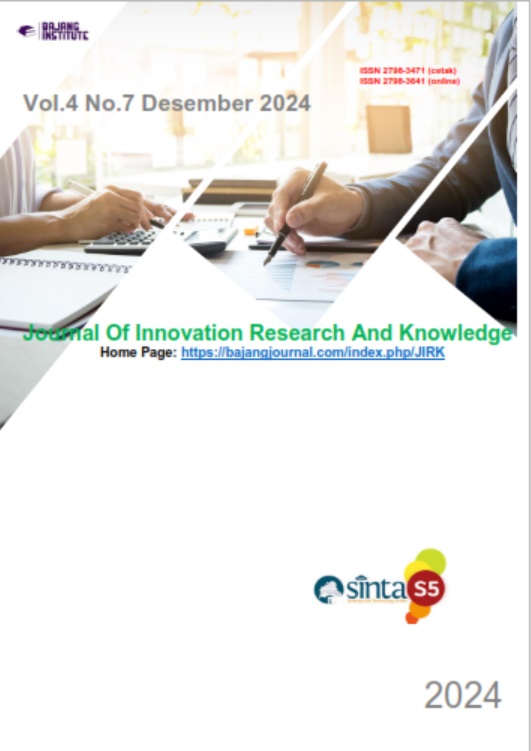DESIGN THINKING APPROACH TO ENHANCE STUDENTS CREATIVITY IN SECOND LANGUAGE WRITING PERFORMANCE
DOI:
https://doi.org/10.53625/jirk.v4i7.9069Keywords:
Students Creativity, Writing, Design Thinking, Writing PerformanceAbstract
This study aims to find out the effect of using design thinking approach on students creativity in write descriptive text. Design thinking approach creates collaboration, creativity and innovation. It arouses a mindset focus from problem to solution, exploring innovation and developing creativity significantly . This research was conducted by using experimental research design. The population was 2nd gr of Junior High Students. The samples of the research were divided into two classes which consisted of experimental and control group. It chosen by using random sampling method. The experimental group was taught by using collaborative learning method while the control group was taught by using conventional method. Data collected by test, test to write descriptive texts completely. After analysing the data, it was found that the value of t-observed was 5.61 with the degree of freedom 40 at the level of significance 1.764, it means that t-observed was higher that t-table (5.61>1.764). The result of this investigation showed that there are significant changes on students descriptive text, that finding explained that design thinking approach effective to enhance the students creativity in second language writing performance significantly.
References
Angelo, T.A., & Cross, K.P.,2003. Classroom Assessment Technique. 2nd Edition. San Francisco:
Jossey Bass.
Brown, T. 2008. Design Thinking Approach in Education. Harvard: Harvard Inc.
Brown, H. Douglas. 2000. Principle of Language Learning and Teaching. New York: Cliff
Byrne, D. 1991. Teaching Writing Skill. Longman Publisher.
Carol, J.A. 2011. Writing and Grammar. New Jersey: Prentice Hall Inc.
Harris , K. 2017. Design Thinking Methodology. The Wallace Foundation, principal leadership.
Fitzpatrick. 2005. Engaging Writing Paragraph and Essay. New York: Longman Inc.
Gibbons, Pauli. 2007.Writing in a Second Language Across the Curriculum. New York: Pearson Education Inc.
Hammer, Jeremy. 2004. How to Teach English. London : London Press.
Haeton, Jb. 1998. Classroom Activities. London : Longman Group.
Harmer, Jeremy.2001. The Practice of English Language Teaching. New York: Pearson Education Limited.
Honig, A. 2001. How to Promote Creative Thinking. Longman.
Hung, W. 2003. A Study of Creative Problem Solving Instruction – A Design and Assessment in
Elementary School Chemistry Courses. Chinese Journal of Science Education.
Hyland, Ken. 2002. Teaching and Researching Writing. Malaysia: Pearson Education Inc.
Gardener, H. 2010. Intelligence Reframed, Multiple Intelligence for the 21 Century.
Garrot, L and Wignell, P. 2004. Making Sense of Functional Grammar. Sydney: Gerd Stabler.
Graves, Donald. 2004. A Fresh Look at Writing. Heinemann : Heinemann Press.
Knapp, Peter and Watkins, Megan. 2015. genre ,text, grammar, Technologies for Teaching and
assessing Writing. Sydney: UNSW Press.
Kelly, T. & Kelly, D. 2013. Writing Creative Confidence. Crown Business Inc.
Longman, J. 2003. College Writing Skills. Fifth Edition. New York: McGraw Hill.
Livingstone, Kathy. 2003. A Guide to Write Basic Essay. (http://members.tripod.com/livingstone
Essay/topic.html. accessed on 20 September 2014.
Oshima, Alice & Hogue, Ann. 1991. Writing Academic English: A Writing and Sentence Structure
Handbook. London: Addison- Wesley Publishing.
Qattami,N. 2010. Methods of Teaching Gifted and Talented Skills. Amman: Dar Al- Maseera.
Richard, Jack, C. and Willy Renandya. 2007.Methodology in Language Teaching. Current Practice London: Cambridge University Press.
Zemach, Dorothy E. and Lisa, A Rumisek. 2006. Academic Writing: From Paragraph to Essay Spain: McMillan.













